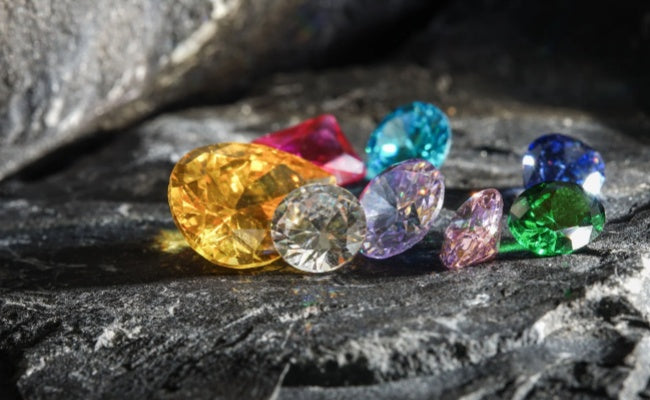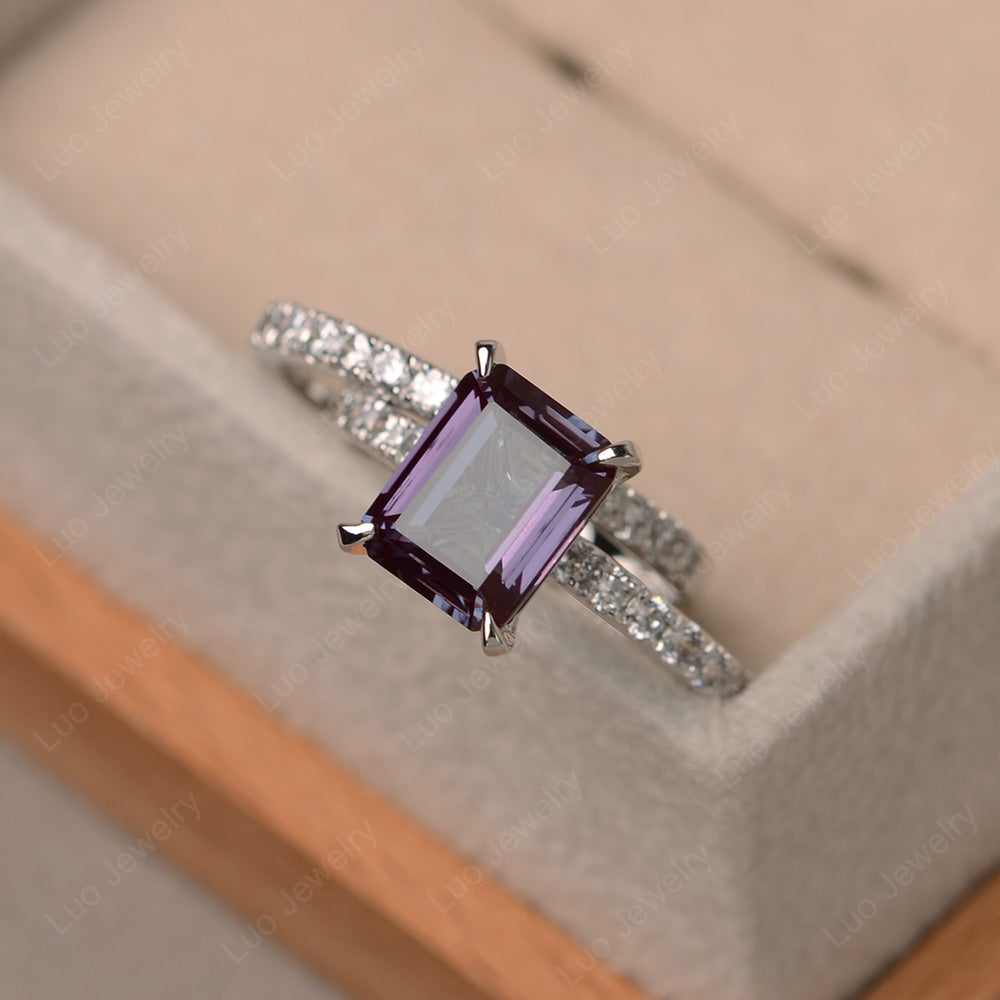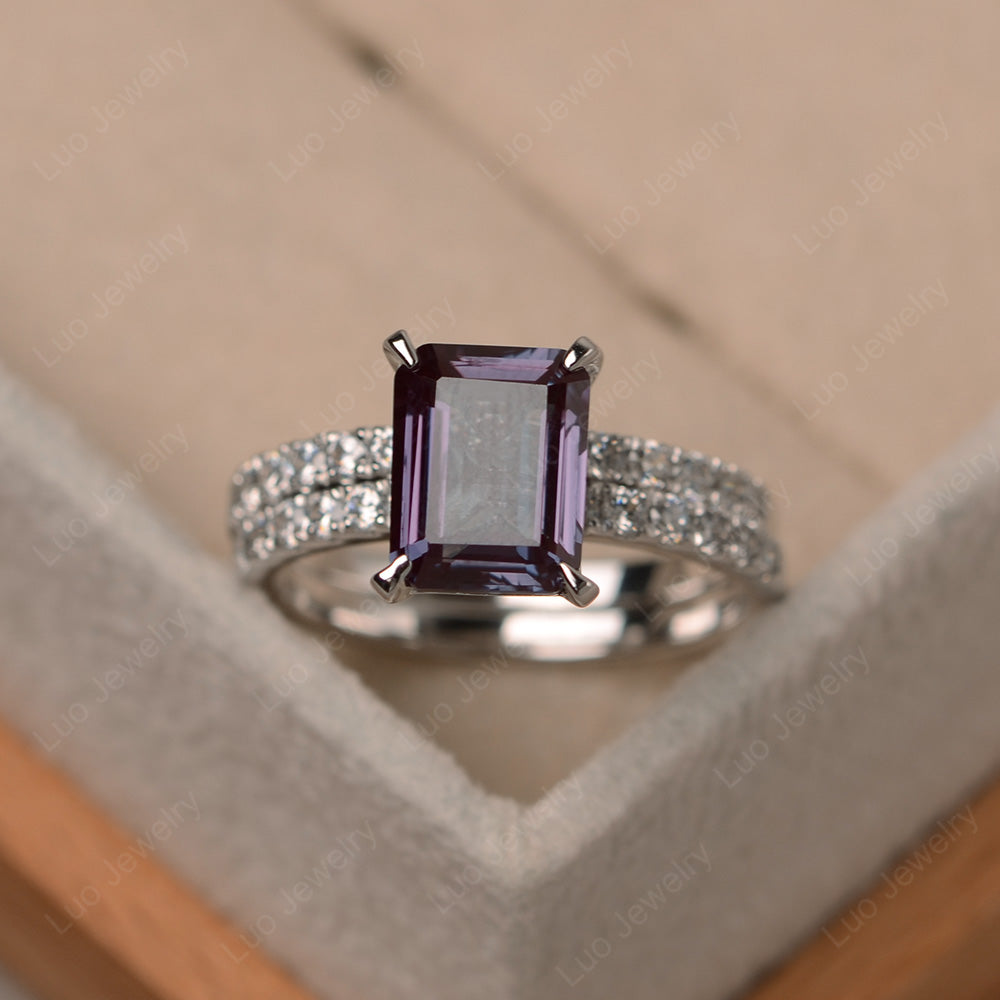 Alexandrite
Alexandrite Amethyst
Amethyst Aquamarine
Aquamarine Black Rutilated Quartz
Black Rutilated Quartz Black Spinel
Black Spinel Cubic Zirconia
Cubic Zirconia Citrine
Citrine Garnet
Garnet Emerald
Emerald Lemon Quartz
Lemon Quartz London Blue Topaz
London Blue Topaz Green Amethyst
Green Amethyst Green Sapphire
Green Sapphire Mystic Topaz
Mystic Topaz Moonstone
Moonstone Moissanite
Moissanite Morganite
Morganite Moss Agate
Moss Agate Opal
Opal Peridot
Peridot Pink Sapphire
Pink Sapphire Rose Quartz
Rose Quartz Ruby
Ruby Sapphire
Sapphire Smoky Quartz
Smoky Quartz Swiss Blue Topaz
Swiss Blue Topaz White Topaz
White Topaz
Lab Grown Alexandrite Rings
Experience the color-shifting magic of alexandrite rings in our June Birthstone Collection. At LUO Jewelry, our lab created alexandrite rings come in classic solitaires, vintage-inspired halos, and modern three-stone styles. With elegant designs in white gold and platinum, each one will express your unique personality.
Sort by
Filters
Alexandrite Rings | Symbol of Mystery, Transformation, and Everlasting Love
Alexandrite is one of the birthstones for June, famed for its rare color-change phenomenon—a vivid green in daylight and a deep purplish-red under incandescent light. This "emerald by day, ruby by night" quality is believed to bring good luck and creativity, and has made it one of the rarest and most precious gemstones in the world. Alexandrite gemstones add extraordinary meaning to engagement rings, anniversary jewelry, and June birthstone jewelry.
LUO Jewelry Alexandrite Ring Collection features carefully selected, high-quality lab-grown alexandrite. Each lab-created alexandrite offers excellent clarity and displays the same color-change intensity and optical effects as natural stones. They are more affordable and ethically sourced, providing a stunning yet eco-friendly alternative to natural alexandrite rings.
Our lab-grown alexandrite ring collection includes alexandrite engagement rings, alexandrite wedding ring sets, and alexandrite eternity rings, designed for customers who seek uniqueness.
Every piece makes the most of the gem’s color-change properties:
- Solitaire alexandrite rings: classic designs that showcase the gem’s color-change beauty.
- Halo alexandrite rings: surround the center stone with diamonds or other gems to create richer light and shadow effects from different angles.
- Three-stone alexandrite rings: symbolize the transformations of your past, present, and future.
- Vintage-style alexandrite rings: designs full of mystery and heirloom charm.
- Modern alexandrite rings: emphasize clean lines so the alexandrite gem’s color-change becomes the sole focal point.
We offer a variety of gem cuts for you to choose from when designing a personalized lab-created alexandrite ring—round brilliant, cushion, oval, emerald cut, pear, heart, and more. Each gemstone cut is optimized to maximize the alexandrite’s color-change effect.
LUO Jewelry lab-grown alexandrite rings are available in sterling silver, 14K/18K white gold, yellow gold, rose gold, and platinum, all handcrafted by experienced artisans using high-quality recycled metals. Each metal interacts differently with the alexandrite’s color change to create a unique visual experience. Our 14K and 18K gold options strike a perfect balance between durability and beauty.
Alexandrite has been celebrated as "the mysterious stone of royalty", its unique color-change charm symbolizing miracles and turning points in love and life. Whether for a proposal, an anniversary, or a June birthday, LUO Jewelry lab-created alexandrite rings are a radiant choice for expressing love and commitment.
Explore the LUO Jewelry lab-grown alexandrite ring collection now, and let every change of light become a brilliant chapter in your love story.
Explore Related Lab Grown Alexandrite Jewelry
Frequently Asked Questions
What is a Lab Grown Alexandrite?
Lab grown alexandrite is a synthetic gemstone created in controlled laboratory environments that replicates the chemical composition and crystal structure of natural alexandrite. These gems are produced using advanced techniques like the Czochralski method or flux growth process, which recreate the conditions under which natural alexandrite forms in the earth. The result is a gemstone that is chemically, physically, and optically identical to natural alexandrite.
👉 Click to Learn More: What is Alexandrite? The Ultimate Guide to Alexandrite Stone
What Color is Alexandrite?
Alexandrite is renowned for its remarkable color-changing properties, typically appearing green or bluish-green in daylight and shifting to red or purplish-red under incandescent light.
Lab grown alexandrite exhibits the same dramatic color-changing phenomenon as natural alexandrite.The exact colors can vary, with some stones showing blue-to-purple changes or green-to-brownish-red transformations.
The color change occurs due to the presence of chromium in the crystal structure, which absorbs different wavelengths of light depending on the light source.
Are Lab Created Alexandrite Real?
Lab created alexandrite is real alexandrite in every scientific sense. It has the same chemical formula, crystal structure, hardness, and optical properties as natural alexandrite. The only difference is its origin - one forms in a laboratory while the other forms in nature over millions of years.
Lab Grown vs Natural Alexandrite, What is the Difference?
The primary differences between lab grown and natural alexandrite include origin, formation time, inclusions, and price. Natural alexandrite forms over geological time periods in the earth's crust, while lab grown versions are created in weeks or months. Natural stones often contain unique inclusions that tell their geological story, whereas lab grown stones may have different inclusion patterns or be virtually flawless. Natural alexandrite is significantly more expensive due to its extreme rarity, while lab grown versions offer the same beauty at a fraction of the cost.
How Rare is Alexandrite?
Natural alexandrite is one of the rarest gemstones on Earth, significantly rarer than diamonds, emeralds, or rubies. It was first discovered in Russia's Ural Mountains in the 1830s, and high-quality deposits are extremely limited worldwide. The specific geological conditions required for alexandrite formation are so uncommon that finding new deposits is extraordinarily rare. This extreme scarcity is why natural alexandrite commands such high prices in the gemstone market.
Is Lab Grown Alexandrite Good?
Lab grown alexandrite offers excellent quality and represents outstanding value for consumers who want the beauty of alexandrite without the premium price of natural stones. These gems can display exceptional color change, clarity, and cut quality. They're particularly appealing for those who prioritize ethical sourcing and environmental considerations, as their production doesn't involve mining. For jewelry purposes, lab grown alexandrite performs identically to natural stones.
Is Alexandrite a Birthstone?
Yes, alexandrite is the traditional birthstone for June, sharing this designation with pearl and moonstone. It was designated as June's birthstone due to its discovery in June 1834 and has remained associated with this month ever since. Many people born in June choose alexandrite for its unique properties and symbolic meaning of change and adaptability.
👉 Click to Learn More:
What Does Wearing a Alexandrite Ring Mean?
Alexandrite symbolizes balance, transformation, and adaptability due to its color-changing nature. It's often associated with creativity, imagination, and the ability to see situations from different perspectives.
Wearing an alexandrite ring is often interpreted as embracing change, balance, and personal growth. The color-changing nature of the stone symbolizes adaptability and the ability to see multiple perspectives. Many wearers feel it represents their own multifaceted nature or their journey through different phases of life. In romantic contexts, alexandrite rings can symbolize a love that endures through all of life's changes and challenges.
Does Alexandrite Make a Good Engagement Ring?
Alexandrite makes an excellent choice for engagement rings, offering both beauty and durability with its 8.5 hardness rating. The gemstone's color-changing properties create a unique and meaningful symbol for a relationship that will evolve and grow over time.
Lab grown alexandrite is particularly appealing for engagement rings as it provides exceptional value while maintaining all the symbolic and aesthetic qualities of natural stones. The rarity and uniqueness of alexandrite also make it perfect for couples seeking something distinctive.
How Much Does a Lab Grown Alexandrite Ring Cost?
Lab grown alexandrite rings typically range from several hundred to several thousand dollars, depending on the stone's size, quality of color change, clarity, cut, and the ring setting. A high-quality lab grown alexandrite of 1-2 carats in a simple setting might cost between $500 to $2,000, while larger stones or elaborate settings can cost significantly more. This represents substantial savings compared to natural alexandrite, which can cost tens of thousands of dollars for similar quality.
Where to Buy Lab Grown Alexandrite Rings?
When it comes to lab-grown alexandrite rings, LUO Jewelry stands out for its exceptional quality, vast array of designs, extensive selection, and highly competitive pricing. Each synthetic alexandrite gem is meticulously handpicked and beautifully integrated into designs ranging from classic solitaire settings, antique halo settings, to romantic toi et moi settings. Regardless of which lab-created alexandrite engagement ring you choose, it will undoubtedly serve as a dazzling symbol that encapsulates your love story.
Is Lab Created Alexandrite Ring Durable?
Lab created alexandrite rings are highly durable with a hardness of 8.5 on the Mohs scale, making them suitable for daily wear. This hardness level means the stone resists scratching from most common materials and maintains its polish well over time. The color-changing properties are permanent and won't fade or diminish with wear. However, like all gemstones, alexandrite can chip or crack if subjected to sharp impacts, so reasonable care should be taken during wear.
How to Clean Lab Grown Alexandrite Rings at Home?
Lab grown alexandrite rings can be safely cleaned at home using warm soapy water and a soft brush to gently remove dirt and oils. Rinse thoroughly and dry with a soft cloth. Ultrasonic cleaners can also be used safely for alexandrite, though steam cleaning should be avoided if the stone has any inclusions or fractures. For deeper cleaning, professional cleaning services can restore the stone's full brilliance. Avoid harsh chemicals and store the ring separately to prevent scratching from harder materials.












